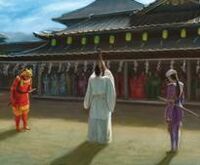
A Duel
Dueling was one of Rokugan's foremost answers to ending personal conflicts. If offense was given to a samurai, then the samurai might choose to challenge the offender to a duel. It was often considered dishonorable for any samurai to refuse a duel under any circumstances, for it was believed that if your cause was just, the kami would guide your blade true to cut down the offending party. [citation needed]
Practice with the Katana[]
As dueling was an integral part of samurai life in Rokugan, every day samurai lived and died by their skills with the katana. Those skills were honed in hours of practice with bokken, wooden training swords. Students were not even allowed to carry a true steel blade until they had years of practice with the bokken under their belt. [1]
Shugenja and Courtiers[]
Because shugenja and courtiers were part of the samurai caste they abided by its rules. It was therefore required that if they were challenged to a duel, they would have to answer as any bushi would. Because they were not generally deemed skilled enough to participate in the duel themselves, they were allowed to have a champion (otherwise known as a second) stand for them, but must face the consequences of loss anyway - more often than not, this meant seppuku. [citation needed]
Mantis Clan[]
Most duels berween members of the Mantis Clan included the drinking of sake before, and sometimes even during, the contest. In the early days of the Clan, conflicts were resolved swiftly in order to maintain order aboard ship or within small villages. Formal duels were preceded by long hours of drinking and celebrating with friends and families of the duelists. Inebriated, the challengers took their favorite weapon, and the individual best able to cope with the effects the alcohol would be the toughest and most willful of the two contestants. [2]
Techniques[]
The most common technique for duels in Rokugan was the Kakita iaijutsu technique. Second to that was the Mirumoto niten technique. Various other schools of dueling existed, but most were based off the Kakita technique, such as the Bayushi (focusing more on misdirection and feinting than a single perfect cut). [citation needed]
See Also[]
- Duel/Meta
- Ketsuiki, duel to first blood
- Shi, duel to the death
- Taryu-jiai, the shugenja duel
References
- ↑ Test of Enlightenment
- ↑ Art of the Duel, p. 74
| This article is a stub. That means that it has been started, but is incomplete. You can help by adding to the information here. |